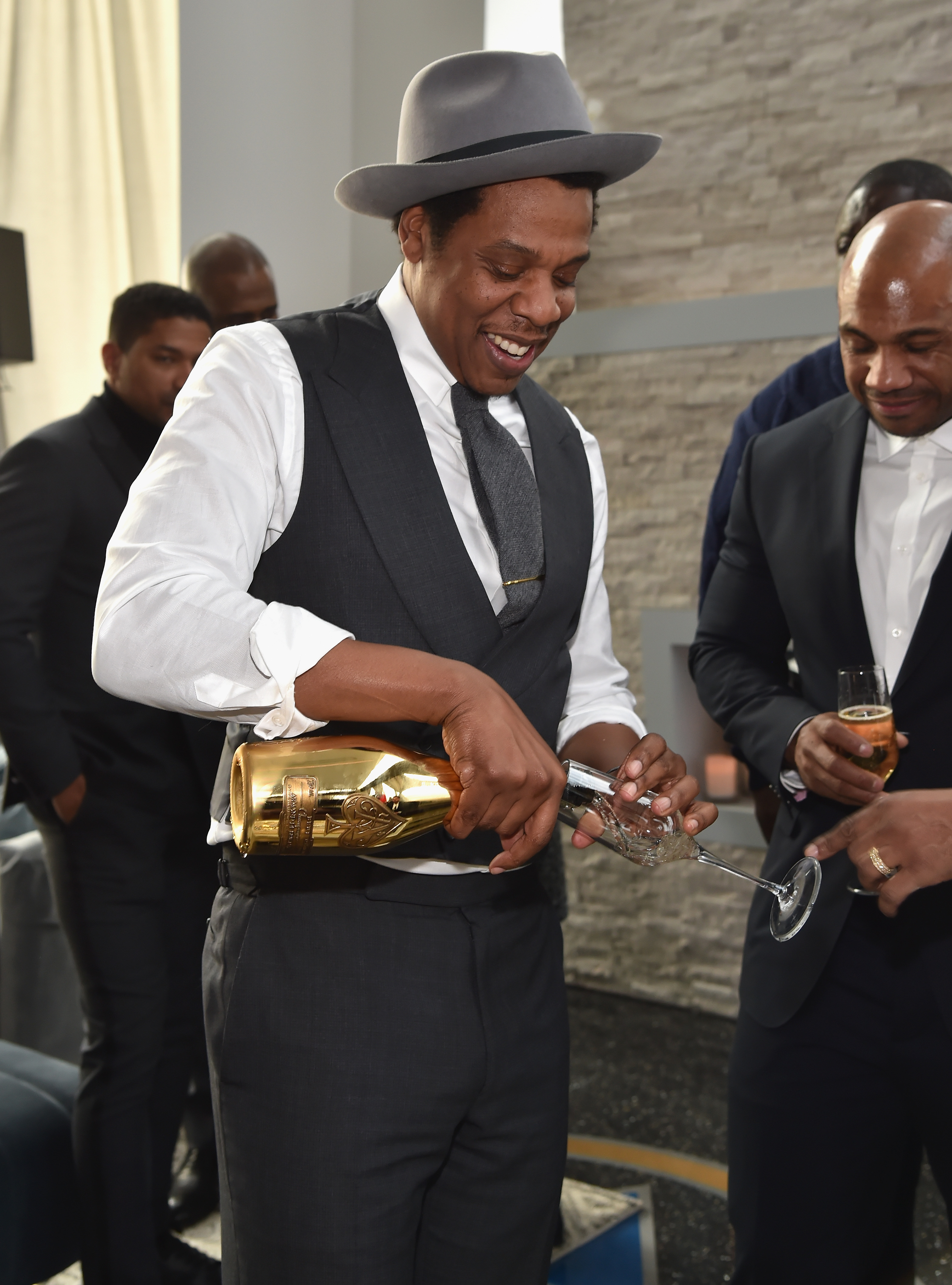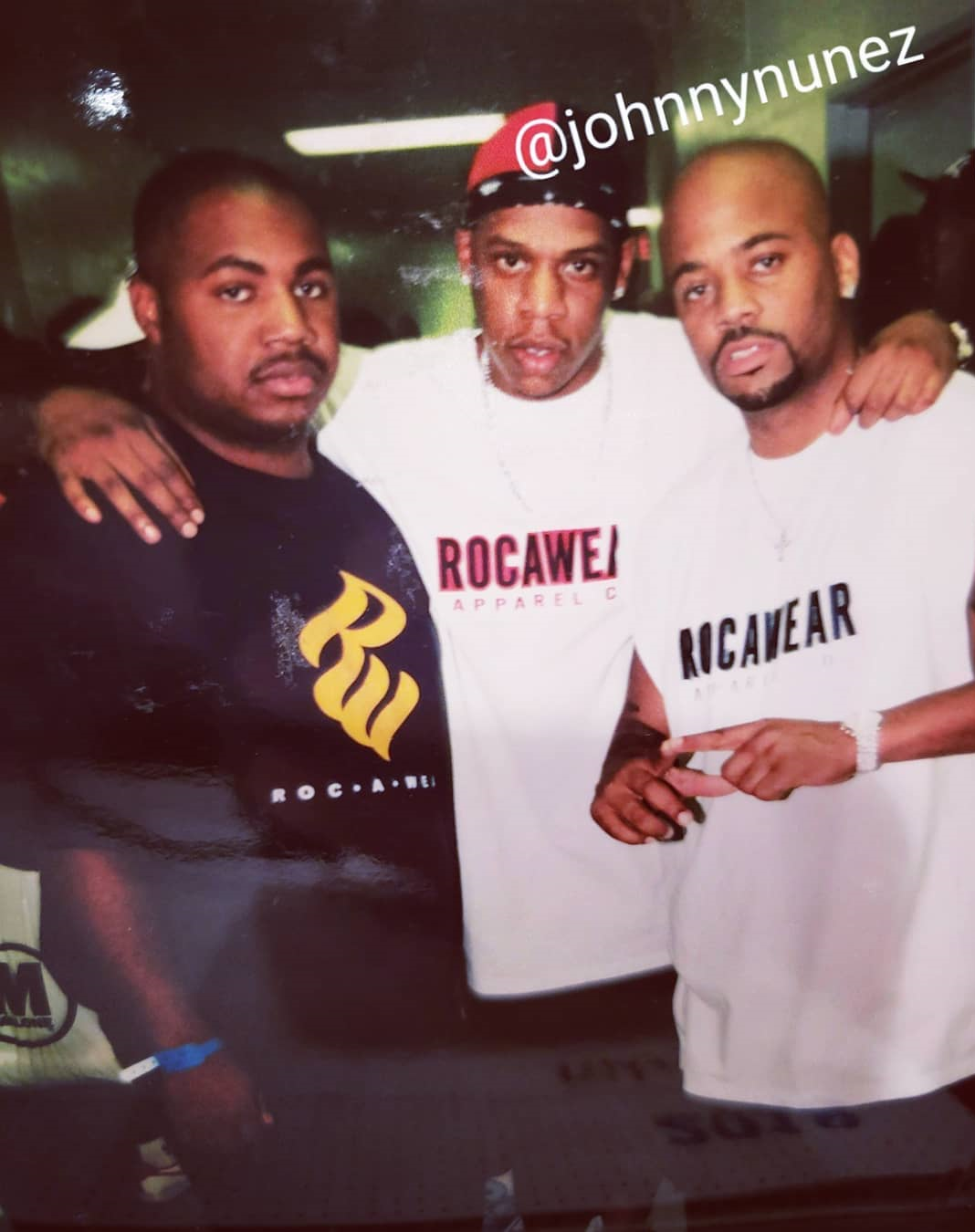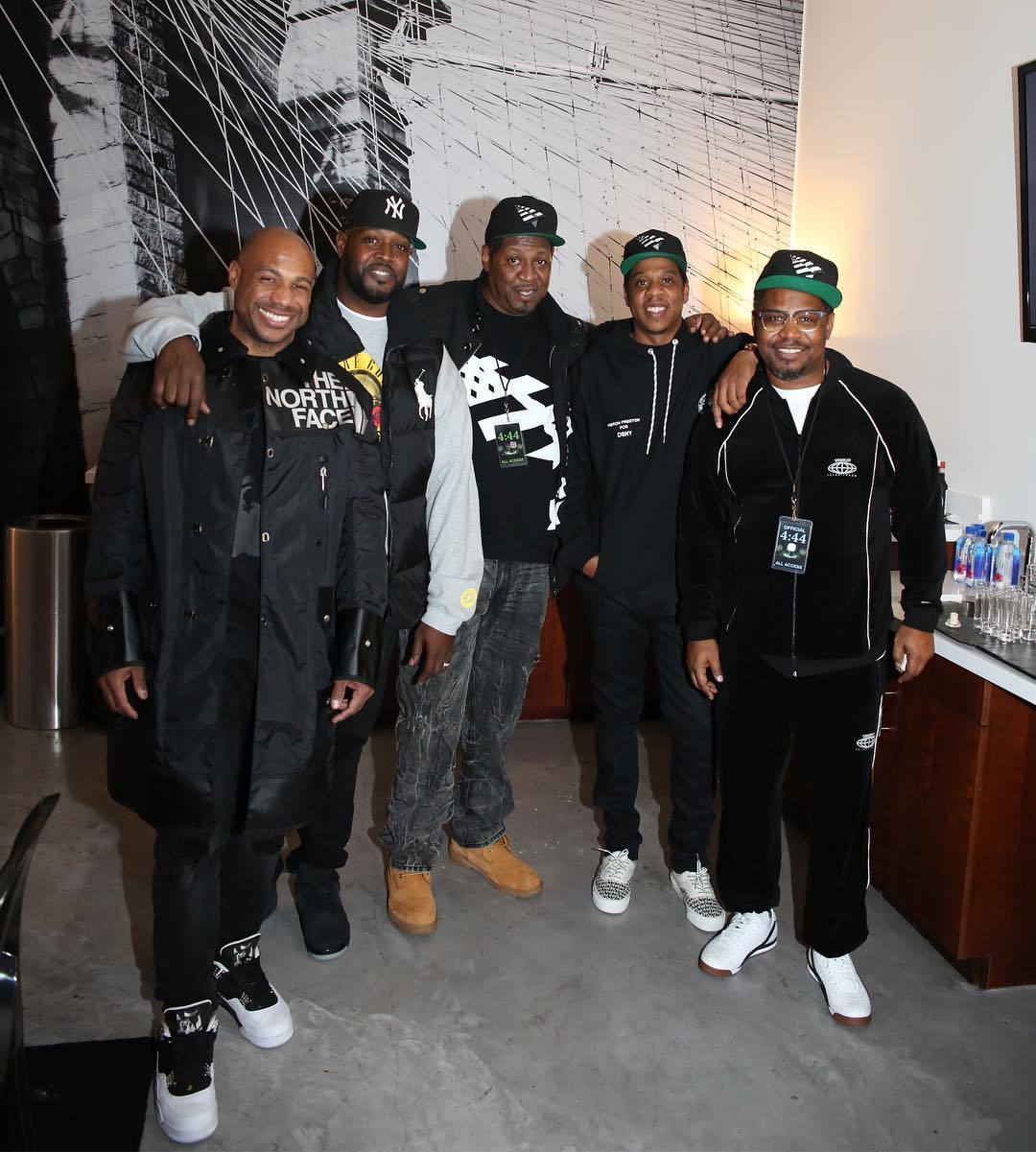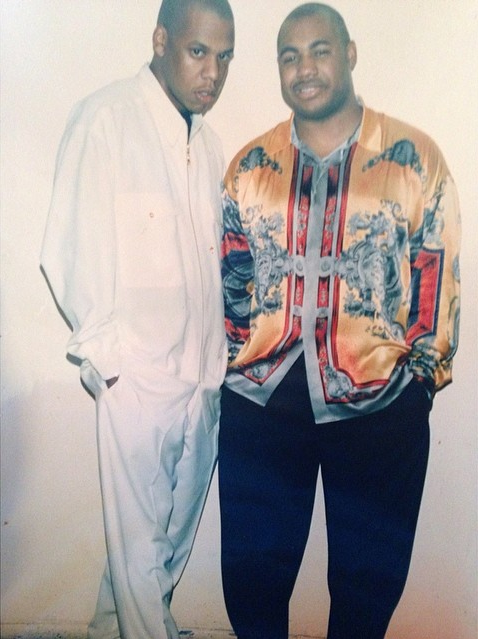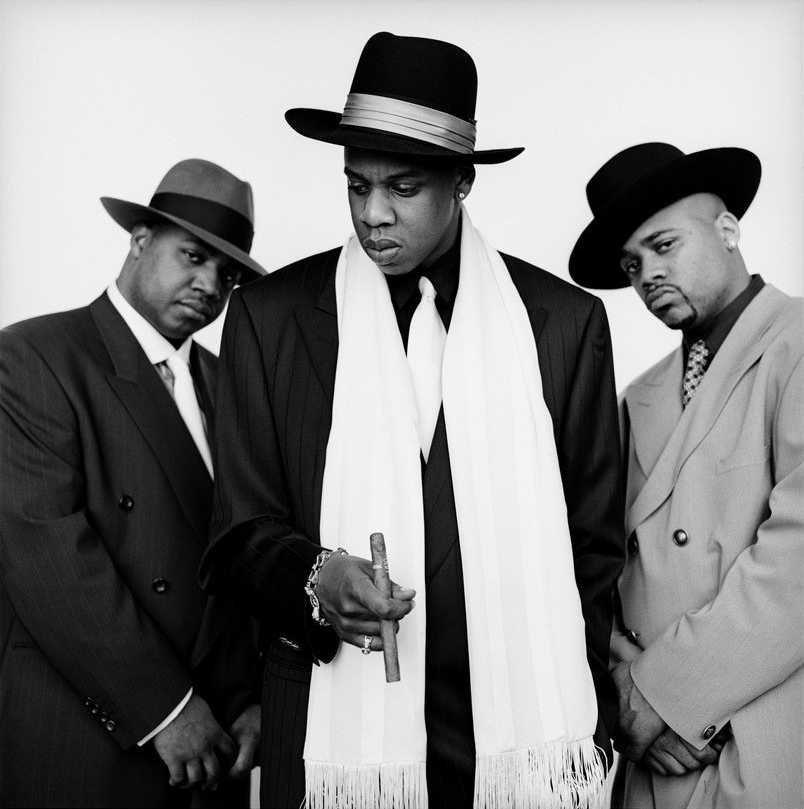
Jaÿ-Z, Kareem “Biggs” Burke and Dame Dash, photographed for the booklet of the rapper’s debut album Reasonable Doubt by Jonathan Mannion on April 1, 1996. This was the month the album was originally intended to be released in, but it was pushed back to June 14, then eventually released on June 25.
A year earlier the three had come together in a joint venture we all know as Roc-A-Fella Records. Throughout ’94 Jaÿ and party promoter Dame had been moving units out the trunk of their Lexus GS300’s and building a reputation all over the state, but weren’t getting anywhere with the labels. So, they decided they would venture the music business on their own, but needed a financial backer to help set the label up right. In came the man with the St. Thomas connects: the quiet and humble Biggs, a friend of Dame’s and a Harlem hustler who had been rather prosperous. After a successful trip to St. Thomas to record an opulent music video for “In My Lifetime,” which Biggs helped fund to the amount of $16,000, the three knew they had something special and officially registered the Roc-A-Fella Records, Inc. corporation in April 1995. Biggs was a silent partner, creeping in the back of photographs, and wasn’t often mentioned in interviews or on tracks.
On October 1, 1995 the artist now known as JAY-Z officially signed to Roc-A-Fella in a deal brokered by his longtime consigliere John Meneilly. He was given a handsome advance to use to record his debut album, with the incorporation having ownership of what he produced. The plan was for Carter to release one album to build respect for the label’s distribution and promotion abilities, then he would step back from the mic and work in his co-CEO role full-time. Early acts signed to the label he intended to mentor after his retirement from the game included Memphis Bleek, Roughness and Christión. However, a partnership offer from Def Jam Recordings in ’97 was too good to pass on, and to fulfil his part of the contract Jigga would return to the studio. The three founded Roc-A-Fella Records LLC in ’97 to enter the 50/50 Def Jam venture, so the major label could never touch their baby.
By March ’96 the majority of the album was recorded, mixed and mastered. During the recording process the project was known as Heir to the Throne due to the experienced rookie backing himself to ascend to the throne once his crown jewel dropped. The Roc-A-Fella art department, under the guidance of Director Adrien Vargas, began to promote the gig on the streets. Label publicist Kasha Payne rang her friend Jonathan Mannion and told him he needed to hurry down to the Roc offices to apply for the job.
At the time the Cleveland native was working as an assistant for Ben Watts, after gaining traction the in the city working for the legendary Richard Avedon for a year and a half. Mannion would work a full day under the tutelage of Avedon then head to the nightclubs to shoot the hip-hop figures partying during a golden age in the city. It was at a downtown club in March ’95 he first shot Jigga during an Eazy-E tribute show. So, in the middle of March the novice, but formally-trained, photographer brought along his portfolio to a meeting with Vargas and co-CEO Dame Dash in a corner office in Suite 1400 of 17 John Street, Lower Manhattan. They all got along, and Mannion was so impressed by the Harlem hustler’s dedication to independence that he offered to charge Roc-A-Fella $300 less than their current lowest quote to secure the right to shoot the 26-year-old Shawn Carter.
A few days Vargas called the photographer and told him he had been awarded him the shoot. Given the album’s title Mannion prepared a regal-themed board to present to the Roc team; with his mother being from London he felt confident in his royalty and monarchy references and was sure they would be satisfied. However, in the days before the shoot Hov made a decision to change the title to Reasonable Doubt. While he and those around him believed he was indeed the heir to the throne of New York, he decided to take a more humble approach and let the listeners, AKA The Jury, have an opportunity to decide if he was throne-worthy. He would tell Mannion that “if I rise to the occasion, I’m going to be named King by the people.”
After hearing of the title change Mannion would be the one to convince Jaÿ-Z and the team to move from the Miami and Scarface-influenced Versace linen, cigarette boat, drug-running motifs to the now-classic New York Mafia crime theme. Mannion encouraged Jaÿ to move differently and “keep it Brooklyn” by using images from the John Gotti collections and Luc Sante’s police surveillance and crime scene photographs from the 1910s as inspiration points. Vargas would jump on the black-and-white nature of these images, realizing how powerful it would be to have the album cover standing out among the heavily-saturated covers of the time. After leaving the John Street offices Mannion headed to the Marcy Houses to get a feel for where the rapper had grown up.
Two days later it was time to shoot, and with a new vision in mind, on the morning of the three Roc-A-Fella co-founders went to a luxury suit store in Manhattan and fitted themselves out in a $10,000 double breasted set each. In the trunk of the rapper’s Lexus were the props: $200,000 in cash and various guns. On set Tyran “Ty Ty” Smith and Emory “Vegas” Jones were making fun of Dame’s small “pea-shooter” handgun he had supplied. The day was full of laughter and brotherhood. Unfortunately the team couldn’t organize the trio’s wish of a vintage Rolls-Royce in time for the session.
The photo shoot took place inside and on the roof of Mannion’s Manhattan spectacularly-lit apartment building, located under the Westside Highway on West 72nd Street and Riverside. He was keen to shoot in Little Italy, but time constraints meant that couldn’t come to fruition. So instead, the shoot “was done in my dusty spare room,” he once recalled in an interview with BET in 2016. “I just dropped the white backdrop, then I shot it all with daylight. It was kind of like my personal little studio, because it’s just empty space with beautiful North light. Up there with my tripod, it’s kinda dusty and funky, but we made it work and it all contributed to the vibe.” After finishing inside, the group headed up to the roof to get some shots in the fading sunlight. “Back then, it was all busted and beat up, and it fit the vibe,” he told Complex. I knew I could get some beautifully composed shots, based on traditional cameras press photographers used back in the Civil Rights era.” Mannion captured 30 rolls of film that day on a Hasselblad with an 80mm lens, a Pentax 67 with a 90mm lens, and a Konica Press. At the end of the shoot Dame picked up one of the purposefully rubber-banded money stacks and peeled off $1,300 to pay the photographer.
Jonathan Mannion counts Reasonable Doubt as one of the greatest albums of all-time, once reckoning to BET how he “speaks about the album as a complete project. Because, over time, there are many artists that deliver amazing singles. And its like, maybe there’s two, three, four good songs on the album and the rest are sort of filler and fluff. That’s kind of a typical analysis of majority of the albums out there. There’s albums that stand out that are complete thoughts from start to finish. I look at Reasonable Doubt as that. The flow, the rhythm, the cadence, the sequencing, everything sort of built on what happened before in order to paint a complete picture of everything that Jaÿ was seeing and around at the time.”
